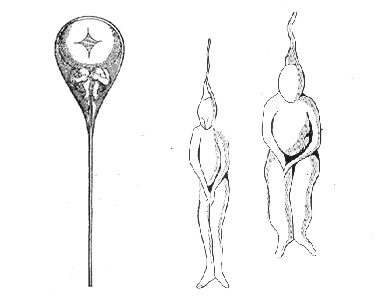The creation of life has always been a human fantasy. According to reports from the 16th and 17th centuries, at that time alchemists started trying to produce a fully formed miniature human body, the homunculus, from a flask.
The term first appears in alchemical writings attributed to Paracelsus (1493 - 1541), a Swiss-German physician and philosopher, a revolutionary of his time. In his work De natura rerum (1537), an outline of his method for creating a homunculus, he wrote: “Let the semen of a man putrefy by itself in a sealed cucurbite with the highest putrefaction of the venter equinus [horse manure] for forty days, or until it begins at last to live, move, and be agitated, which can easily be seen…If now, after this, it is everyday nourished and fed cautiously and prudently with [an] arcanum of human blood…it becomes, thenceforth, a true and living infant, having all the members of a child that is born from a woman, but much smaller”.
This method doesn't pass the test of modern sciences, as with many of Paracelsus' theories. But he is frequently credited with the recognition of psychological conditions among other things. It was Nicolas Hartsoeker (1656 - 1725), a Dutch mathematician and physicist, who postulated the existence of animalcules in the semen of humans and other animals. He believed that the sperm was, in fact, a "little man" placed inside a woman's body to grow into a child. The spermists, a rational explanation for many of the mysteries of conception, would be a homunculus identical in everything, except the size, to an adult.
 Homunculi in sperm illustrated by Hartsoeker, 1695.
Homunculi in sperm illustrated by Hartsoeker, 1695.
What's noteworthy is how women were not considered to be a valid part in the baby-making process. That is almost ironic given the fact that five centuries later, one of the feminists biggest argument was that women were reduced to "baby machines". In 1970, American feminist Shilamith Firestone famously said that "the end of the sex-class system must mean the end of the biological family, that is, the end of women's biological reproductive role through artificial means of gestation". She surely wasn't endorsing the spermists belief, but hinting something else. Should artificial womb really come true one day, what would it mean for our society? How will it influence the concept of kinship and motherhood?
This article is part of the Artificial Womb research project by NNN. The goal of this project is to develop thought-provoking scenarios that facilitate a much-needed discussion about the way technology radically alters our attitude towards reproduction, gender, relationships and love in the 21st century. We highly value your feedback or input, contributions can be sent to womb@nextnature.net.
Image: Wikicommons


Comments (0)
Share your thoughts and join the technology debate!
No comments yet
Be the first to share your thoughts!